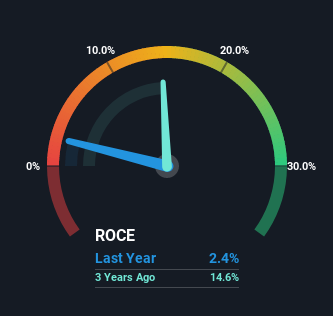- Hong Kong
- /
- Specialty Stores
- /
- SEHK:3813
Investors Could Be Concerned With Pou Sheng International (Holdings)'s (HKG:3813) Returns On Capital

If you're not sure where to start when looking for the next multi-bagger, there are a few key trends you should keep an eye out for. Ideally, a business will show two trends; firstly a growing return on capital employed (ROCE) and secondly, an increasing amount of capital employed. If you see this, it typically means it's a company with a great business model and plenty of profitable reinvestment opportunities. Having said that, from a first glance at Pou Sheng International (Holdings) (HKG:3813) we aren't jumping out of our chairs at how returns are trending, but let's have a deeper look.
What Is Return On Capital Employed (ROCE)?
For those who don't know, ROCE is a measure of a company's yearly pre-tax profit (its return), relative to the capital employed in the business. Analysts use this formula to calculate it for Pou Sheng International (Holdings):
Return on Capital Employed = Earnings Before Interest and Tax (EBIT) ÷ (Total Assets - Current Liabilities)
0.024 = CN¥232m ÷ (CN¥15b - CN¥5.7b) (Based on the trailing twelve months to June 2022).
Thus, Pou Sheng International (Holdings) has an ROCE of 2.4%. In absolute terms, that's a low return and it also under-performs the Specialty Retail industry average of 11%.
Our analysis indicates that 3813 is potentially undervalued!

Above you can see how the current ROCE for Pou Sheng International (Holdings) compares to its prior returns on capital, but there's only so much you can tell from the past. If you'd like, you can check out the forecasts from the analysts covering Pou Sheng International (Holdings) here for free.
What Does the ROCE Trend For Pou Sheng International (Holdings) Tell Us?
On the surface, the trend of ROCE at Pou Sheng International (Holdings) doesn't inspire confidence. Over the last five years, returns on capital have decreased to 2.4% from 13% five years ago. Given the business is employing more capital while revenue has slipped, this is a bit concerning. This could mean that the business is losing its competitive advantage or market share, because while more money is being put into ventures, it's actually producing a lower return - "less bang for their buck" per se.
In Conclusion...
We're a bit apprehensive about Pou Sheng International (Holdings) because despite more capital being deployed in the business, returns on that capital and sales have both fallen. It should come as no surprise then that the stock has fallen 61% over the last five years, so it looks like investors are recognizing these changes. That being the case, unless the underlying trends revert to a more positive trajectory, we'd consider looking elsewhere.
One more thing to note, we've identified 1 warning sign with Pou Sheng International (Holdings) and understanding this should be part of your investment process.
If you want to search for solid companies with great earnings, check out this free list of companies with good balance sheets and impressive returns on equity.
New: Manage All Your Stock Portfolios in One Place
We've created the ultimate portfolio companion for stock investors, and it's free.
• Connect an unlimited number of Portfolios and see your total in one currency
• Be alerted to new Warning Signs or Risks via email or mobile
• Track the Fair Value of your stocks
Have feedback on this article? Concerned about the content? Get in touch with us directly. Alternatively, email editorial-team (at) simplywallst.com.
This article by Simply Wall St is general in nature. We provide commentary based on historical data and analyst forecasts only using an unbiased methodology and our articles are not intended to be financial advice. It does not constitute a recommendation to buy or sell any stock, and does not take account of your objectives, or your financial situation. We aim to bring you long-term focused analysis driven by fundamental data. Note that our analysis may not factor in the latest price-sensitive company announcements or qualitative material. Simply Wall St has no position in any stocks mentioned.
About SEHK:3813
Pou Sheng International (Holdings)
An investment holding company, engages in distributing and retailing sportswear and footwear in the People’s Republic of China and internationally.
Flawless balance sheet and undervalued.


